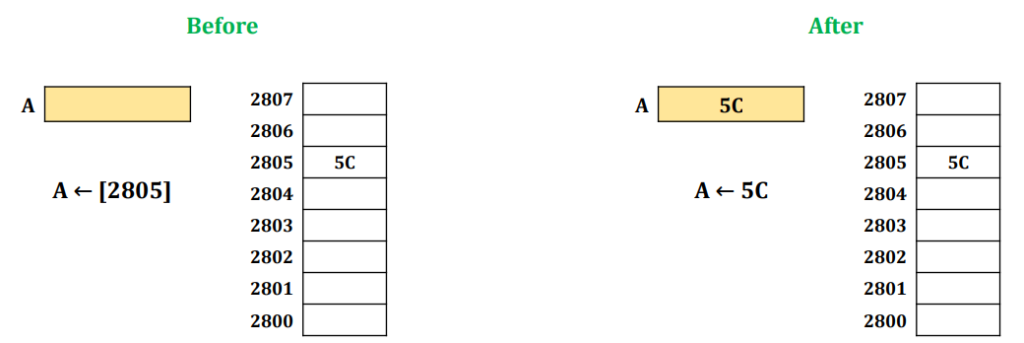Addressing modes are techniques used to specify the memory address or data location that an instruction should operate on.These modes define how the CPU interprets the operand (an input or output value) part of an instruction.

MOV B, A [Here MOV is operation and (B & A) are operands.]
ADD B [Here ADD is operation and (B) is operand.]
The way in which the operand is taken from register or memory is named as addressing mode.
Addressing modes play a crucial role in determining how data is accessed and manipulated during program execution.
Here are some common addressing modes:
- Implied addressing mode:
- The instruction itself implies the operand or data source/destination without the need for specifying an explicit memory address or register.
- Example:
HALTthe instruction “HALT” is used to stop the execution of the program
- Immediate Addressing:
- The operand is a constant value or literal embedded in the instruction itself.
- Example:
MOVI A, 15hA ← 15h Here 15h is the immediate operand
- Register Addressing:
- The operand is a value stored in a processor register.
- Example:
ADD BA ← A + B Here B is the operand specified in register
- Direct Addressing:
- The operand is the memory address where the data is located.
- Example:
LOAD R1, 1000loads the content of memory address 1000 into register R1.
- Indirect Addressing:
- Indirect addressing uses a memory location to indirectly specify the operand’s location.
- Example:
LOAD R1, (R2)loads the content of the memory address stored in register R2 into register R1.
- Indexed Addressing:
- A base address is added to an index or offset to access the operand.
- Example:
LOAD R1, (R2 + 20)loads the content of the memory address calculated by adding 20 to the content of register R2 into register R1.
- Base-Indexed Addressing:
- Combines base and index registers to calculate the operand’s address.
- Example:
LOAD R1, (R2 + R3)loads the content of the memory address calculated by adding the contents of registers R2 and R3 into register R1.
- Relative Addressing:
- The operand’s address is specified relative to the current instruction’s location.
- Example:
JUMP -5jumps to an instruction 5 locations before the current instruction.
- Stack Addressing:
- Involves pushing data onto a stack or popping data from it.
- Example:
PUSH R1pushes the content of register R1 onto the stack.
- PC-Relative Addressing:
- The operand’s address is relative to the program counter (PC).
- Example:
BRANCH -5branches to an instruction 5 locations before the current PC.
- Base or Segment Register Addressing:
- Uses base or segment registers to specify a base address, and addressing modes use these registers to calculate the operand’s address.
Different computer architectures support various addressing modes, and the choice of mode depends on the specific instruction set and programming needs. Addressing modes provide flexibility and efficiency in accessing data and instructions in memory, contributing to the versatility and performance of a CPU.
Examples:
- Register Indirect Addressing Mode
MOV A , M A ← [[H][L]]
It moves the data from memory location specified by HL register pair to A.

2. Direct Addressing Mode
LDA 2805h A ← [2805]
It loads the data from memory location 2805 to A.

Important Question on Addressing Modes with Answer:
1. What are addressing modes in computer architecture?
- Addressing modes are techniques used to specify how the CPU accesses data or instructions in memory during program execution.
2. How do addressing modes affect program execution?
- Addressing modes determine how operands are located, fetched, and processed, influencing the flow and efficiency of program execution.
3. How many addressing modes are there in typical computer architectures?
- Different computer architectures offer various addressing modes, but there are usually a handful of common ones.
4. What is immediate addressing mode, and when is it used?
- Immediate addressing mode involves using constant values directly in instructions. It is often used for simple arithmetic and comparisons.
5. When is register addressing mode employed?
- Register addressing mode involves specifying one or more processor registers as operands. It is used for efficient data manipulation within the CPU.
6. What is the purpose of direct addressing mode?
- Direct addressing mode refers to specifying the memory address of the operand directly in the instruction. It is used for accessing specific memory locations.
7. How does indirect addressing mode work?
- Indirect addressing mode uses a memory location to indirectly specify the operand’s location. It is employed for flexible memory access.
8. Can you explain the indexed addressing mode?
- Indexed addressing mode involves adding an offset to a base address to access data. It is often used in array operations.
9. What is the significance of the stack addressing mode?
- Stack addressing mode is used for managing the stack, which is essential for function calls and local variable storage.
10. How does relative addressing mode operate?
Relative addressing mode specifies operands relative to the current instruction’s location. It is commonly used for branching and jumps.
11. What is PC-relative addressing mode, and why is it useful?
– PC-relative addressing mode specifies operands relative to the program counter (PC). It simplifies branching and conditional jumps in programs.
12. How do base or segment register addressing modes function?
– These modes use base or segment registers to specify a base address, enabling efficient memory access with relative offsets.
13. Are there addressing modes used for vector processing?
– Yes, vector addressing modes are used in vector processors to perform operations on arrays or vectors of data efficiently.
14. How do compilers and assemblers interact with addressing modes?
– Compilers and assemblers generate machine code that utilizes addressing modes, abstracting low-level details for programmers.
15. Can addressing modes impact program portability?
– Yes, the choice of addressing modes can affect how easily a program can be ported to different CPU architectures due to differences in addressing capabilities.
0 Comments